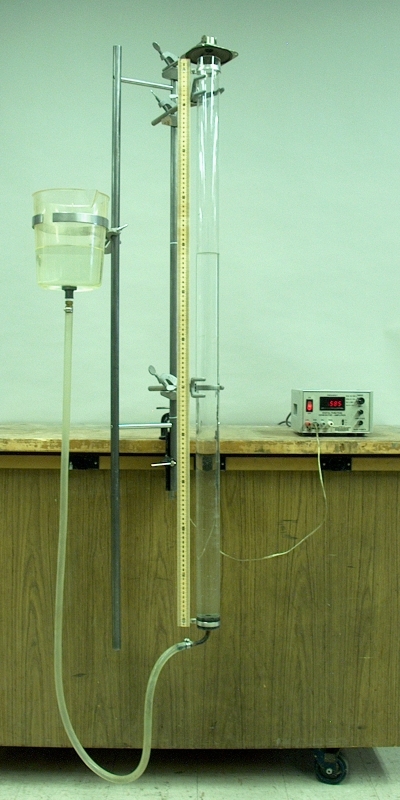
A function generator drives a small speaker set above the opening of a plastic pipe. An opening in the bottom end of the plastic pipe is connected to an opening in the bottom of a plastic beaker by a length of flexible plastic tubing, so that water can flow between the two, and you can adjust the level of the water in the tube by raising and lowering the plastic beaker. For a given frequency setting of the function generator, you can find lengths of the air column for which resonance occurs, by listening for maxima in the volume of the sound as you vary the water level by raising or lowering the beaker. A scale next to the plastic pipe allows you to measure the length of the vibrating air column. Please note: When you are working with short air columns, be careful not to raise the water level too high. The waves whose properties you are demonstrating are longitudinal waves. That is, they travel along the central axis of the pipe. If, however, the length of the air column is comparable to the inner diameter of the pipe, it becomes possible for transverse modes to occur, which introduce errors in the frequencies and wavelengths you measure for the longitudinal waves. For this reason, it is good to keep the water level several pipe diameters below the top of the pipe.
The top of the tube is open, and at the bottom, the surface of the water constrains the motion of the molecules in the vibrating air column. The tube thus acts as a pipe that has one open end and one closed end. Since reflection of the sound wave occurs 180 degrees out of phase at a closed end, but in phase at an open end, the only standing waves that can survive in the tube are those for which a (displacement) node occurs at the surface of the water, and a (displacement) antinode occurs at the open end. This means that resonance occurs only when the length of the air column in the tube corresponds to odd multiples of quarter wavelengths, i.e., λ/4, 3λ/4, 5λ/4, etc. For a given frequency, then, depending on how many odd quarter wavelengths fit within the tube, you may be able to observe resonance for several levels of the water, where the levels are one half wavelength apart (3λ/4 - λ/4 = λ/2; 5λ/4 - 3λ/4 = λ/2, etc.).
You can also set the water at a particular level and then tune the function generator to frequencies for which resonance occurs. Since the frequency, ν, equals v/λ, where v is the speed of sound in air, and l, the length of the air column, must correspond to λ/4, 3λ/4, 5λ/4, etc., the harmonics occur at ν = v/4l, 3v/4l, 5v/4l, etc. From the lowest frequency upward, then, if we call the fundamental ν0, the harmonics should be at ν0, 3ν0, 5ν0, etc.
The reason for the word “displacement” in parentheses above, in reference to nodes and antinodes, is that in a sound wave, the motion of molecules is least within the compressions, the regions of high pressure, and greatest within the rarefactions, the regions of low pressure. Thus, a displacement node corresponds to a pressure antinode, and a displacement antinode corresponds to a pressure node. When people speak of nodes and antinodes in sound waves, it is probably most common for them to be referring to displacement nodes and antinodes. Since it may be advantageous to use one or the other depending on context, however, I note it here for clarity.
For a discussion of the musical intervals that occur among the series of odd-quarter-wavelength harmonics, please see the page for demonstration 44.33 -- Speaker over pipes.